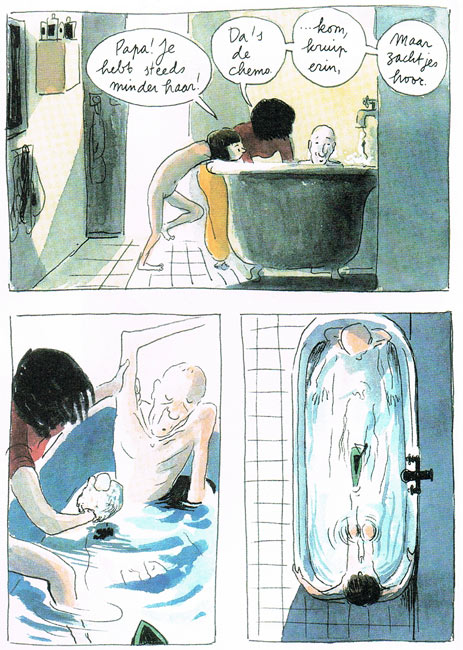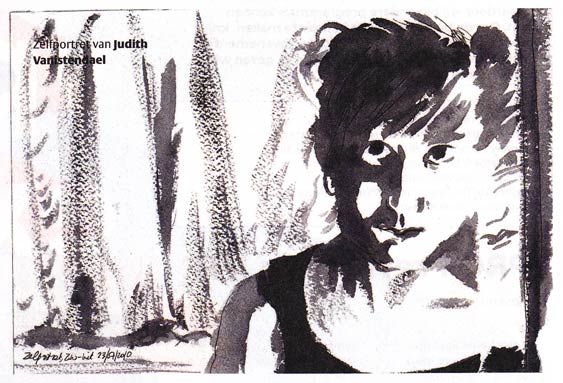'Dance by the Light of the Moon', part 2.
Judith Vanistendael is a Flemish comic author, illustrator and teacher in comic art. Her critically acclaimed autobiographical debut 'Dance by the Light of the Moon' (2009) firmly established her as one of Belgium's most important contemporary graphic novelists. It was followed by the moving 'When David Lost His Voice' and the socially conscious 'Salto' (2016), which she made in cooperation with Mark Bellido. Thanks to her ground-breaking graphic novels, Vanistendael has been called the Belgian Posy Simmonds.
Early life
Judith Vanistendael was born in 1974 in Leuven as the daughter of Belgian poet, novelist, essayist and journalist Geert van Istendael. She is the granddaughter of the equally well known Belgian union man and politician August Vanistendael (Geert spells his last name differently, as a pseudonym). After graduating from high school, Judith attended art school in Ghent and lived in the German capital Berlin for a year, where she took courses at the Hochschule der Kunsten. After returning to Belgium, she studied art sciences in Ghent for four years, followed by a postgraduate in Sevilla, Spain. Vanistendael counts Rembrandt Van Rijn, Egon Schiele, Gustav Klimt, Amadeo Modigliani and Japanese traditional art among her graphical influences, but tries to evoke the atmosphere of these artists more than directly copying the art. She always enjoyed drawing, but became fascinated with graphic storytelling through authors like Manu Larcenet, Craig Thompson, Christophe Blain, Marjane Satrapi, Joann Sfar and Dupuy & Berberian. Quentin Blake has been an important inspiration for her children's book illustrations.
Early illustration career
Vanistendael's graphic career started when she illustrated her father's collection of Flemish fairy tales: 'Vlaamse Sprookjes' (1995), as well as Bibi Dumon Tak's 'Het Koeienboek' (2001). In 2000, she studied at the Sint-Lukas School of Arts in Brussels, where she took a course in comics. Among her teachers were Pascal Lefèvre, Nix and Gerard Alsteens, better known as Gal. Her early comic stories were published in alternative magazines like Demo, Ink, Zone5300 and Bruxxxel Noord. As a children's book illustrator, she has worked for publishers like Atlas, Querido, Malmberg and Lannoo. Since 2010 she makes the illustrations for Michael de Cock's book series about the two Brussels children 'Rosie en Moussa'. The books were adapted into the film 'Rosie & Moussa' (2018), directed by Dorothée Van Den Berghe.
'Dance by the Light of the Moon', part 1.
Dance by the Light of the Moon
Vanistendael's two-part autobiographical graphic novel 'De Maagd en de Neger' ('Dance by the Light of the Moon') was based on the author's relationship with a political refugee from Togo in the 1990s. To her surprise and anger, her nonetheless progressive father felt prejudiced about her romance with the immigrant Abou. He even wrote down his distress in the short story 'Bericht uit de Burcht', which appeared in his book 'Veldwerk in Vlaanderen' (2001). Her father's story formed the basis for the first installment of Vanistendael's diptych, called 'Papa en Sofie' (Oog & Blik/De Harmonie, 2007). It is told from the viewpoint of the father, who gradually lets down his guard when he witnesses how the Belgian government treats refugees. Vanistendael married her boyfriend, but cultural clashes and more personal problems eventually resulted in a divorce. She still remains on good terms with him, though. In the second volume, the now-divorced woman and single mother, called Sofie in the books, reflects on her relationship with Abou and the ordeals he underwent in Togo. This story was first serialized in the newspaper De Standaard in May-June 2009, and then published in book format under the title 'Leentje en Sofie' (Oog & Blik/De Bezig Bij, 2009).
The author told her otherwise distressing story in a loving and captivating way, using a loose black-and-white drawing style. Even though 'De Maagd en de Neger' was Vanistendael's graduation project from Sint-Lukas, her debut gained much press attention upon its release. The fact that her famous father had a prominent role in it might be one reason, but overall the book was critically acclaimed in its own right for the serious and topical subject matter. The graphic novel became Vanistendael's signature work, and was translated into French ('La Jeune Fille et Le Nègre'), English ('Dance By The Light Of The Moon'), German ('Kafka für Afrikaner'), Italian ('Sofie e Abou') and Spanish ('Sofia Y El Negro'). It earned her two nominations on the prestigious Angoulême comic festival of 2009: one for "Best Debut" and one for "Best Album".
'Toen David Zijn Stem Verloor'.
Watercolor painting
Judith Vanistendael picked up watercolor painting when she walked the Camino pilgrimage to Santiago de Compostela in Spain. She decided to make one painting a day, all the while training her skills in this technique. The results were later exhibited in the Maison des Cultures et de la Cohésion Sociale in the Brussels town Molenbeek. Vanistendael's philosophical journey was also chronicled in the illustrated diary 'Pelgrim of Niet?', first published by Oog & Blik in October 2012. The publisher however pulled back the book shortly afterwards, claiming the printing quality did not meet up to high standards. It took until 2015 before it was re-released.
When David Lost His Voice
Vanistendael decided to also use watercolors for her follow-up graphic novel, a moving story about the final months of a man with throat cancer. 'Toen David Zijn Stem Verloor' ('When David Lost His Voice', 2012) was dedicated to her mother's partner, who also passed away from this disease, but is nonetheless not autobiographical. Vanistendael told her story from the viewpoints of the man's second wife and one of his two daughters, resulting in an honest portrait of love and loss. It was translated into French ('David, Les Femmes et La Mort'), German ('Als David seine Stimme verlor'), Spanish ('Los Silencios de David'), Swedish ('När David tappade rösten') and Korean and met with similar critical acclaim as her debut. 'When David Lost His Voice' was nominated for three Eisner Awards, but won none.
Salto
For her next book, Vanistendael desired a change of pace, and a less heavy or personal theme. She teamed up with the writer Mark Bellido (1975), who had spent four years protecting Basque politicians against the ETA. His experiences formed the basis for 'Salto', an action-packed comic about a candy salesman who becomes a bodyguard of Spanish politicians. The massive work of over 350 pages was drawn by Vanistendael with colored pencils and felt-tip pens. The book proved a challenge, since she had to switch from intimate storytelling to the craft of building tension. She, however, drew the book in the aftermath of the Paris terrorist attacks of November 2015, and witnessed the war against terrorists firsthand, as suspects were apprehended right across the street of her Molenbeek atelier. 'Salto' (2016) was published in French by Le Lombard, and in Dutch by De Bezige Bij, under the title 'Mikel'.
Penelope
Vanistendael turned to paint brushes for her next book, 'Penelope' (Oogachtend, 2019), a poetic tale about motherhood and priorities. Loosely inspired by the mythological Penelope, wife of Odysseus, the title hero is a doctor with Médecins Sans Frontières ('Doctors Without Borders') who saves lives in Syria and Somalia, but on the other hand is absent in the life of her teenage daughter back home.
Studio & comics journalism
Judith Vanistendael at first shared a studio space with architect Barbara Roosen in Molenbeek's former Belle-Vue brewery, where they were eventually joined by Wauter Mannaert and Eva Hilhorst. By the end of 2012, the group moved to a larger studio in Schaarbeek. They nicknamed themselves "De Geslepen Potloden" ("The Sharpened Pencils") and were quickly joined by other artists, including five French-language colleagues from the L'Employé du Moi publishing label. Vanistendael eventually settled in her own atelier at the border of Molenbeek's rough Heyvaertwijk. The rapidly changing quarter is known for its large African population, and has been the subject of a comics documentation project initiated by Axel Claes since late 2016. Vanistendael and Jeroen Janssen participated, and spent an afternoon sketching the local population. Their report was published in Stripgids #2 in December 2017.
In October 2017, Judith Vanistendael, Aimée de Jongh and Mei-Li Nieuwland headed for the Greek island Lesbos. Their mission was to make comics reports and an artist's impression of life in the refugee camp Kara Tepe, where filming and photography are not allowed. Vanistendael's chronicle was published in the Flemish newspaper De Standaard on 9 December. The moving reports of De Jongh and Nieuwland were published on the website of newspaper NRC on 22 December 2017.
'Moria - Hellhole on Earth' (Judith Vanistendael's comics report from Lesbos).
Teacher in comic art
All in all, Vanistendael is not an artist who likes to settle in one drawing style or technique. The desire to produce artistically interesting work is also one of her spearheads at the LUCA School of Arts in Brussels, where she is a teacher in comic art. She likes to challenge her students to overcome obstacles, which also leads to new experiments in her own oeuvre. The toddlers's picture book 'Blokje Om' (Querido, 2018) for instance, which tells a story from collages with cut-out pieces of colored paper. Among her students were Nathalie Carpentier, Veerle Hildebrandt and Yannick Pelegrin.
Graphic contributions
In 2020, Vanistendael joined 75 Dutch & Flemish comic artists to make a graphic contribution to the free collective comic book 'Striphelden versus Corona’ (Oogachtend, Uitgeverij L, 2020). The book was intended to support comics stores who had to close their doors for two months during the lockdown at the height of the COVID-19 virus pandemic.
Recognition
On 9 September 2022, it was announced that Vanistendael won the Flemish comic prize De Bronzen Adhemar. After Erika Raven (in 1987), she is the second woman to receive this award.
Other projects
On 18 May 2009, a comic book mural designed by Vanistendael, 'Couleur Café', was inaugurated at the Place Saint-Josse / Sint-Joostplaats in the Rue Willems / Willemsstraat in Brussels, as part of the Brussels' Comic Book Route. On 11 July 2011, Pieter De Poortere designed a comics mural in the Rue Euler in Paris, starring characters created by Judith Vanistendael, Brecht Evens, Olivier Schrauwen, Randall Casaer and Jeroen Janssen to promote Flemish comic strips. This was the first of its kind in France. In 2016, Vanistendael was one of the participating comic authors in the Belgian-Korean comics exposition, organized by the Korean Cultural Centre in Brussels.
Since 2016, Vanistendael is part of the editorial board of the restyled Flemish comics news magazine Stripgids, together with comic artists Nix, Simon Spruyt and Marc Legendre, and journalists Karl van den Broeck and Roel Daenen.
Legacy and influence
Judith Vanistendael was an influence on Inge Bogaerts and has also received admiration from Mimi Pond.
Self-portrait (2010).










